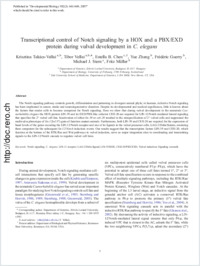Transcriptional control of Notch signaling by a HOX and a PBX/EXD protein during vulval development in C. elegans
- Takács-Vellai, Krisztina Department of Genetics, Eötvös Loránd University, Budapest, Hungary - Department of Biology, University of Fribourg, Switzerland
- Vellai, Tibor Department of Genetics, Eötvös Loránd University, Budapest, Hungary
- Chen, Estella B. Yale University School of Medicine, Department of Genetics, New Haven, CT, USA - Department of Biological and Physical Sciences, Kennesaw State University, Kennesaw, USA
- Zhang, Yue Department of Biology, University of Fribourg, Switzerland
- Guerry, Frédéric Department of Biology, University of Fribourg, Switzerland
- Stern, Michael J. Yale University School of Medicine, Department of Genetics, New Haven, CT, USA
- Müller, Fritz Department of Biology, University of Fribourg, Switzerland
-
04.10.2006
Published in:
- Developmental Biology. - 2007, vol. 302, no. 2, p. 661–669
notch signaling
C. elegans
LIN-12 receptor
LAG-2/Delta ligand
LIN-39/HOX
CEH-20/PBX/EXD
vulval induction
signaling crosstalk
English
The Notch signaling pathway controls growth, differentiation and patterning in divergent animal phyla; in humans, defective Notch signaling has been implicated in cancer, stroke and neurodegenerative disorders. Despite its developmental and medical significance, little is known about the factors that render cells to become competent for Notch signaling. Here we show that during vulval development in the nematode Caenorhabditis elegans the HOX protein LIN-39 and its EXD/PBX-like cofactor CEH-20 are required for LIN-12/Notch-mediated lateral signaling that specifies the 2° vulval cell fate. Inactivation of either lin-39 or ceh-20 resulted in the misspecification of 2° vulval cells and suppressed the multivulva phenotype of lin-12(n137) gain-of-function mutant animals. Furthermore, both LIN-39 and CEH-20 are required for the expression of basal levels of the genes encoding the LIN-12/Notch receptor and one of its ligands in the vulval precursor cells, LAG-2/Delta/Serrate, rendering them competent for the subsequent lin-12/Notch induction events. Our results suggest that the transcription factors LIN-39 and CEH-20, which function at the bottom of the RTK/Ras and Wnt pathways in vulval induction, serve as major integration sites in coordinating and transmitting signals to the LIN-12/Notch cascade to regulate vulval cell fates.
- Faculty
- Faculté des sciences et de médecine
- Department
- Département de Biologie
- Language
-
- English
- Classification
- Biological sciences
- License
-
License undefined
- Identifiers
-
- RERO DOC 7831
- DOI 10.1016/j.ydbio.2006.09.049
- Persistent URL
- https://folia.unifr.ch/unifr/documents/300264
Statistics
Document views: 178
File downloads:
- pdf: 215
